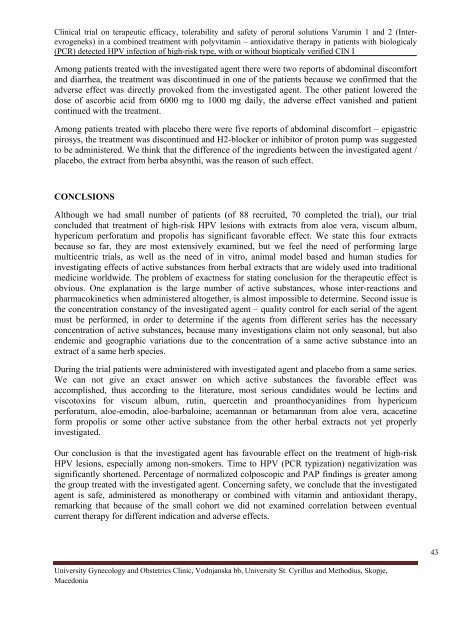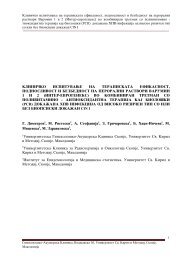klini^ko ispituvawe na terapiskata efikasnost, podnoslivost i
klini^ko ispituvawe na terapiskata efikasnost, podnoslivost i
klini^ko ispituvawe na terapiskata efikasnost, podnoslivost i
You also want an ePaper? Increase the reach of your titles
YUMPU automatically turns print PDFs into web optimized ePapers that Google loves.
Clinical trial on terapeutic efficacy, tolerability and safety of peroral solutions Varumin 1 and 2 (Interevrogeneks)<br />
in a combined treatment with polyvitamin – antioxidative therapy in patients with biologicaly<br />
(PCR) detected HPV infection of high-risk type, with or without biopticaly verified CIN I<br />
Among patients treated with the investigated agent there were two reports of abdomi<strong>na</strong>l discomfort<br />
and diarrhea, the treatment was discontinued in one of the patients because we confirmed that the<br />
adverse effect was directly provoked from the investigated agent. The other patient lowered the<br />
dose of ascorbic acid from 6000 mg to 1000 mg daily, the adverse effect vanished and patient<br />
continued with the treatment.<br />
Among patients treated with placebo there were five reports of abdomi<strong>na</strong>l discomfort – epigastric<br />
pirosys, the treatment was discontinued and H2-blocker or inhibitor of proton pump was suggested<br />
to be administered. We think that the difference of the ingredients between the investigated agent /<br />
placebo, the extract from herba absynthi, was the reason of such effect.<br />
CONCLSIONS<br />
Although we had small number of patients (of 88 recruited, 70 completed the trial), our trial<br />
concluded that treatment of high-risk HPV lesions with extracts from aloe vera, viscum album,<br />
hypericum perforatum and propolis has significant favorable effect. We state this four extracts<br />
because so far, they are most extensively examined, but we feel the need of performing large<br />
multicentric trials, as well as the need of in vitro, animal model based and human studies for<br />
investigating effects of active substances from herbal extracts that are widely used into traditio<strong>na</strong>l<br />
medicine worldwide. The problem of exactness for stating conclusion for the therapeutic effect is<br />
obvious. One expla<strong>na</strong>tion is the large number of active substances, whose inter-reactions and<br />
pharmacokinetics when administered altogether, is almost impossible to determine. Second issue is<br />
the concentration constancy of the investigated agent – quality control for each serial of the agent<br />
must be performed, in order to determine if the agents from different series has the necessary<br />
concentration of active substances, because many investigations claim not only seaso<strong>na</strong>l, but also<br />
endemic and geographic variations due to the concentration of a same active substance into an<br />
extract of a same herb species.<br />
During the trial patients were administered with investigated agent and placebo from a same series.<br />
We can not give an exact answer on which active substances the favorable effect was<br />
accomplished, thus according to the literature, most serious candidates would be lectins and<br />
viscotoxins for viscum album, rutin, quercetin and proanthocyanidines from hypericum<br />
perforatum, aloe-emodin, aloe-barbaloine, aceman<strong>na</strong>n or betaman<strong>na</strong>n from aloe vera, acacetine<br />
form propolis or some other active substance from the other herbal extracts not yet properly<br />
investigated.<br />
Our conclusion is that the investigated agent has favourable effect on the treatment of high-risk<br />
HPV lesions, especially among non-smokers. Time to HPV (PCR typization) negativization was<br />
significantly shortened. Percentage of normalized colposcopic and PAP findings is greater among<br />
the group treated with the investigated agent. Concerning safety, we conclude that the investigated<br />
agent is safe, administered as monotherapy or combined with vitamin and antioxidant therapy,<br />
remarking that because of the small cohort we did not examined correlation between eventual<br />
current therapy for different indication and adverse effects.<br />
University Gynecology and Obstetrics Clinic, Vodnjanska bb, University St. Cyrillus and Methodius, Skopje,<br />
Macedonia<br />
43



